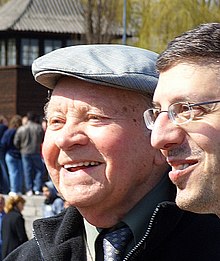Slaves of the gas chamber
| Movie | |
|---|---|
| German title | Slaves of the gas chamber - The Jewish special command in Auschwitz |
| Original title | Slaves of the gas chamber |
| Country of production | Germany |
| original language | German |
| Publishing year | 2001 |
| length | 44 minutes |
| Rod | |
| Director | Eric Friedler |
| production | Eric Friedler |
| music | Ronny Schreinzer |
| occupation | |
| synchronization | |
|
Otto Sander | |
The interview film by the Australian-born journalist and director Eric Friedler " Slaves of the gas chamber - The Jewish special command in Auschwitz " was shown for the first time on TV on ARD on January 24, 2001, 11:30 pm. Above all, the film shows a meeting between Shlomo Venezia (1923–2012) and his fellow sufferer in the prisoner special detachment of the Nazi extermination camp Auschwitz-Birkenau Henryk Mandelbaum (1922–2008) decades after the events in Rome. You tell the interviewer about the final act of the extermination of the Jews (Shoah, Holocaust) in the Nazi concentration campswith the gas chambers of the German occupiers in Poland, the later so-called extermination camps . Here the Nazi criminals of the camp SS forced some of the victims to take part in the "removal of traces" of the mass murders under horrific living conditions. They were forced to carry the bodies from the gas chambers to the crematorium or the cremation pits. First, however, the corpses had to be examined for valuables hidden in the body orifices and gold teeth had to be extracted or broken out of the jawbone.
After their liberation, some of these former prisoners first testified to the Allied investigative commissions or during legal proceedings. But otherwise most of these victims remained silent for decades - also within their families - about the time in which they had been forced to act like this.
Less than five percent of these “Sonderkommando” prisoners survived the war and the Auschwitz death camp in the chaos of the last days of the war. According to the SS leadership, their reports from the secret area of the extermination of the Jews should never have become known. The calculation of the concentration camp leadership wanted to prevent living witnesses of their mass murder by shooting the members of the respective "Sonderkommando" after a few months and "replacing" them with new prisoners who had come to the camp. In May 1944, when over 350,000 mainly Hungarian Jews were murdered in the Auschwitz-Birkenau concentration camp, there were 874 prisoners, while at the end of October 1944 there were only about 100 men.
The uprising of the Sonderkommando against the SS guards is also told in the film.
literature
- Eric Friedler , Barbara Siebert, Andreas Kilian: Witnesses from the death zone: the Jewish special command in Auschwitz. Deutscher Taschenbuch Verlag, Munich, 2005, 416 pages. ISBN 3-423-34158-0 (The book is based on the preliminary work, the research for the film. Three reviews at Perlentaucher.de and by Armin Owzar at hsozkult - in detail, 2008. A first edition of the book was published in 2002 by Bleicher-Verlag .)
- Gideon Greif : We wept without tears ... eyewitness reports from the Jewish 'Sonderkommando' in Auschwitz. Cologne, 1995; New edition Frankfurt am Main, 1999, ISBN 3-596-13914-7 ; Jerusalem, 1999 (Hebrew); Warsaw, 2002 (Polish); New Haven, 2003 (English).
- Gideon Greif : Uprising in Auschwitz. The revolt of the Jewish “Sonderkommando” on October 7, 1944 (with the help of Itamar Levin). Translated from the Hebrew by Beatrice Greif. Cologne 2015, ISBN 978-3-412-22473-8 .
- Henryk Mandelbaum: Report by a contemporary witness . In: Bettina Schaefer (Hrag.): Let's talk about Auschwitz . Brandes & Apsel, Frankfurt am Main 2009. ISBN 978-3-86099-391-0 . Pp. 45-60.
- Igor Bartosik, Adam Willma: Me from the Auschwitz Crematorium - Conversation with Henryk Mandelbaum, former prisoner of the special command in KL Auschwitz, State Museum Auschwitz-Birkenau 2017. ISBN 978-83-7704-199-4
- Shlomo Venezia: My work in the Auschwitz Sonderkommando: The first comprehensive testimony from a survivor. In collaboration with Béatrice Prasquier. Preface by Simone Veil . From the French by Dagmar Mallett. Blessing, Munich, 2008, ISBN 3-89667-365-3 .
- Jan Poludniak: Special. An interview with Sonderkommando member Henryk Mandelbaum. Frap-Books, Oswiecim 2008. ISBN 978-83-921567-3-4
- Piotr MA Cywinski: Henryk Mandelbaum: I from the Auschwitz Crematorium (2009). In: Markus Roth / Sascha Feuchert (ed.): Holocaust testimony literature. 20 works read again. Wallstein, Göttingen 2018. ISBN 978-3-8353-3292-8
See also
- Chronology of the crimes from 1940 to 1945 in the Auschwitz concentration camp complex and the affiliated industrial companies (missing from WP)
- The Gray Area , US drama film about the subject, directed by Tim Blake Nelson in 2001; it came into cinemas in Germany around four years later.
- Son of Saul (Original title: Saul fia) is a Hungarian drama film from 2015, director and writer László Nemes with Clara Royer
Web links
- Slaves of the gas chamber - The Jewish special command in Auschwitz. At Aktion Kinder des Holocaust , 2000,
- All background information on the film as well as reviews and exclusive photo material at https://sonderkommando-studien.de/tv-radio/
- Slaves to the gas chamber in theInternet Movie Database(English)
Individual evidence
- ↑ (in Wikipedia Data on the staff in concentration camps in the category KZ-staff , for. Example, in the concentration camp Auschwitz to find)
- ↑ z. B. the minutes of the so-called 1. Auschwitz Trial in Frankfurt / M, especially from the 96th day of the trial, October 2, 1964 (see the table of witness statements on the website The End of Silence , tape recordings, transcripts provided by the Fritz Bauer Institute ).
- ↑ or the protocols of the Nuremberg main trial of war criminals on the charge of crimes against humanity in 1945/46 .
- ^ Danuta Czech or shortened by Klaus v. Münchhausen (from the same source)
